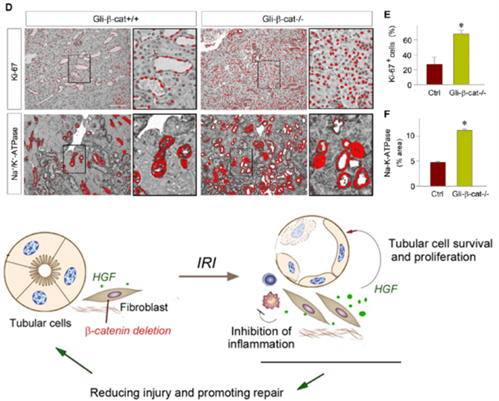
Fibroblast-Specific β-catenin Signaling Dictates the Outcome of AKI
Dong Zhou, Haiyan Fu, Liangxiang Xiao, Hongyan Mo, Hui Zhuo, Xiaojun Tian, Lin Lin, Jianhua Xing and Youhua Liu
Abstract: AKI is a devastating condition with high morbidity and mortality. The pathologic features of AKI are characterized by tubular injury, inflammation, and vascular impairment. Whether fibroblasts in the renal interstitium have a role in the pathogenesis of AKI is unknown. In this study, we investigated the role of fibroblast-specific β-catenin signaling in dictating the outcome of AKI, using conditional knockout mice in which β-catenin was specifically ablated in fibroblasts (Gli1-β-cat−/−). After ischemia-reperfusion injury (IRI), Gli1-β-cat−/− mice had lower serum creatinine levels and less morphologic injury than Gli1-β-cat+/+ littermate controls. Moreover, we detected fewer apoptotic cells, as well as decreased cytochrome C release; reduced expression of Bax, FasL, and p53; and increased phosphorylation of Akt, in the Gli1-β-cat−/− kidneys. Gli1-β-cat−/− kidneys also exhibited upregulated expression of proliferating cell nuclear antigen and Ki-67, which are markers of cell proliferation. Furthermore, Gli1-β-cat−/− kidneys displayed suppressed NF-κB signaling and cytokine expression and reduced infiltration of inflammatory cells. Notably, loss of β-catenin in fibroblasts induced renal expression of hepatocyte growth factor (HGF) and augmented the tyrosine phosphorylation of c-met receptor after IRI. In vitro, treatment with Wnt ligands or ectopic expression of active β-catenin inhibited HGF mRNA and protein expression and repressed HGF promoter activity. Collectively, these results suggest that fibroblast-specific β-catenin signaling can control tubular injury and repair in AKI by modulating HGF expression. Our studies uncover a previously unrecognized role for interstitial fibroblasts in the pathogenesis of AKI.
